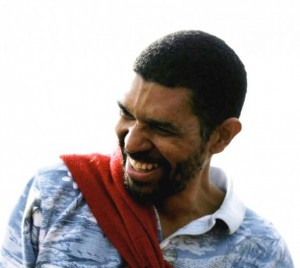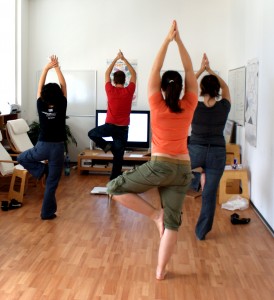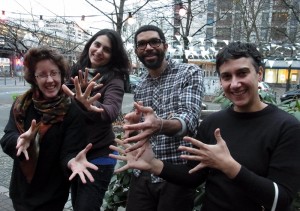On the second part of our series about preventing yoga injuries, we give some tips for teachers, and on how to deal with common injury points.
7. For yoga teachers – pay attention to your own needs when demonstrating poses.
Believe it or not, most yoga injuries occur to teachers rather than students. As teachers, we often demonstrate a pose with our necks craned to the side to see what the students are doing, or we move out too quickly to assist a student. It’s a job that takes multi-tasking skills. While also being aware of what the students are doing, the teacher also has to be aware of their own movements and postures.
Some tips: Ground yourself before beginning the class. Warm up. Prepare the class ahead of time, with ample time built into the plan to demonstrate exercises while also going around to assist the students. Don’t teach options for a pose that you yourself have not practiced many times, and use caution when demonstrating new or challenging poses.

Practical Tips for common injury points:
In any pose where the body is being supported against gravity (i.e. standing), activating as many muscles in the body as possible makes the pose easier, and causes less stress on the body parts that are doing the main supporting. So, for example, even when standing, if you activate the thigh muscles (by pulling up the kneecaps), and activate the abdominal muscles (pull the navel up and back), then standing becomes easier and less stress occurs on the ankles and feet.
Wrists:
When the body’s weight is on the hands, such as in downward dog or plank, the shoulder blades should be flat to the back (this hooks the weight onto the upper back which is stronger than the wrists), the fingers spread wide, and the palms flat (this distributes the weight). Lifting a little at the wrist, and pulling the triceps up into the armpits also helps to alleviate pressure on the wrists. If you have an existing wrist injury, you can also roll up a towel, blanket or mat, and place it under the wrists, rolling the weight forward onto the fingers and taking a little more pressure off. Pressing the heels back and down sends more weight to the back of the body, and activating the abdominal muscles helps to keep the body supported in the centre.
Knees:
Whenever the knees are bent, such as in warrior 1 or 2, or chair pose, keep them directly above the ankles as much as possible, and bending in the direction of the feet. When the knees are bent too severely, or wing out to the side, stress is put on the knee. An already-aggravated knee will get worse in this situation. And if holding the pose is too difficult, then shorten your stance – bring the back foot closer and take less of a bend in the knee. Whenever the legs are straight, pull the kneecaps up and enact the thigh muscles, this takes weight off the underside of the knees and helps build muscle around them. It also avoids hyperextension if you are double-jointed. When sitting on the heels, take a blanket between the feet or a block on top of the heels to sit up a little higher. When kneeling, take a blanket or pillow under the knees. When moving into lotus or other sitting poses that require twisting the legs up, then move only into a position you can hold comfortably. If you it’s too difficult to get close, ask for a modification.
Lower back:
If you have an already existing injury in the lower back, it’s advisable that you make sure with a doctor that doing yoga is appropriate for you. Some injuries could get worse by practicing posture-based yoga. If you are clear to go, then pay particular attention to what the rest of your body is doing as well as taking care of your back. Abdominal muscles are key to strengthening the lower back against further injury. If your back rounds as you lower down into a forward bend, then bends the knees until your back is straight (heart forward, shoulders back, bending from the hip sockets), and pull the belly in as you bend. If your back hurts too much to do back bends (bow, bridge, camel), then don’t do them. If you can, then move into the pose slowly, keep the legs active, pressing the pelvis and hips forward and tailbone towards the knees. Turning the toes and knees out a little bit can help alleviate some pressure in the lower back as well. Also follow back bends with gentle twists and/or a wide-kneed child’s pose, and avoid deep forward bends until the lower back has had some time to lengthen again.
Neck:
If you see the neck as an extension of the spine and it moves with it, then that helps to avoid most neck injuries. The problem is our necks get a major workout as we look this way and that, drop the head if it feels too heavy, etc. But dropping the head is exactly what can cause those injuries to begin with! Keeping the neck long helps make poses like push-up easier. In cobra or upward facing dog, lengthen rather than compress the back of the neck. You should feel no folds in the back of the neck, and the chin tucks slightly in towards the throat. In poses like camel, where the shoulder blades come together, you can let your head fall back only if it has somewhere to rest. And if the head is back, don’t yank the head up again when you come back out of the pose, keep it back until you are upright and can lift your head without straining the neck. In inverted poses (headstand, handstand, shoulderstand), keeping strong shoulders pulled up and away from the ears actually help to protect the neck, rather than the instinct to pull the shoulders close. When your neck is already injured, avoid headstands and shoulderstands.
Throat:
Particular attention should be paid in bridge and shoulder stand to avoid harming the throat. As almost the whole body weight is being supported by this one area. The throat gets compressed and if the rest of the body is not compensating, damage to the vocal chords can occur. Squeezing the shoulder blades together and pressing them flat to the ground causes the spine to lift and gives the back of the neck more space to lay on the ground, allowing the front to be more open. And move slowly into a fully vertical shoulder stand, being aware of your neck and throat as you move.
We offer yoga in Berlin, Kreuzberg. Our teachers are injury conscious and will be happy to assist you before and throughout the class with tailored variations for your yoga poses. We believe that the increased awareness that we cultivate in our yoga classes together with the suggested variations for your unique body, make a difference both to practicing yoga in daily life and to the yoga benefits you take with you after class.







 Throughout the month of April, English Yoga Berlin offers you the chance to bring someone new for free to our
Throughout the month of April, English Yoga Berlin offers you the chance to bring someone new for free to our  English Yoga Berlin’s
English Yoga Berlin’s 










